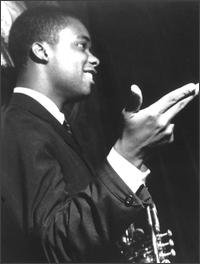The next sentence is predictable as it is inevitable: Freddie Hubbard, had he happened to die at some point in the late (or even mid-) ‘60s, would have been forever lamented as one of the all-time great jazz trumpet players. He still should be, despite doing the very unhip thing and living a fairly good, fairly long life (he passed away Monday at age 70). In fairness to those with whom Hubbard fell out of favor (right around the same time jazz music in general tended to fall out of favor: in the early ‘70s): Hubbard’s finest work, by far, was made during the same decade so much of the greatest jazz music was made: the ‘60s. Two words: Blue Note. Freddie Hubbard, as much as any of the myriad A-list names from that time, was one of the heavyweights of that invaluable label—as a hotshot session player, and also as a leader of his own bands.
The people with whom he played—and made truly groundbreaking records—speaks volumes about the musician: Ornette Coleman (on the seminal Free Jazz session, from 1960), John Coltrane (the criminally overlooked Ole Coltrane, from 1961), Sonny Rollins (another overlooked masterwork, East Broadway Rundown, from 1966). He also appeared on some of the best-loved jazz albums ever, including Herbie Hancock’s Maiden Voyage (1965), Oliver Nelson’s The Blues and the Abstract Truth (1961), Wayne Shorter’s Speak No Evil (1964) and Eric Dolphy’s Out to Lunch!, (1964).
And then there is the considerable string of stellar recordings he made as a leader. A (very) short list of essential albums must include his remarkable debut from 1960, Open Sesame (when he was all of 22 years old), Ready for Freddie (1961), Red Clay and Straight Life (both from 1970). For my money, I’d also insist on throwing in three extremely undervalued efforts, 1962’s The Artistry of Freddie Hubbard, which includes a spirited take of the standard “Summertime” and an incendiary original number, “The 7th Day”; Blue Spirits (a fantastic session from 1965 well worth checking out for the title track alone), and finally, from the less-friendly ‘70s, Sky Dive, which provides a full-funk assault and has plenty of post-Miles cool quotient.
Speaking of Miles, it is hard to get around the Cool One when making any type of historical assessment of significant trumpet players, he looms that large. After (necessarily) bringing Clifford Brown into the equation (who, like Art Tatum and the piano, is often considered the penultimate player of his instrument even if he is not the best known or most frequently listened to), you have the genuine died-before-their-time duo of Lee Morgan and Booker Little. Then, maybe, talk turns to Freddie Hubbard. This is a shame, and Hubbard deserves better (not to take anything whatsoever away from any of the geniuses listed above). If one wanted to take stock of Hubbard’s place simply by considering the albums he was invited to appear on, it would be difficult to name a similarly influential or sought-after artist. Hubbard’s always energetic, often exhilarating voice speaks for itself, and needs no one to augment or embellish the official record. It is, as always, on the records.
Finally, for anyone curious to see for themselves why Hubbard is so beloved by the types of folks who tend to love jazz musicians, virtually any of the albums mentioned above come enthusiastically recommended. In terms of the unique and even ecstatic sounds Hubbard made with his horn, I’d turn to my favorite tunes from sessions he did not lead: “Hat and Beard” (from Dolphy’s Out to Lunch!, “Stolen Moments” (from Nelson’s The Blues and the Abstract Truth), “Dahomey Dance” (from Coltrane’s Ole Coltrane), “East Broadway Rundown” (from Rollins’ East Broadway Rundown) and “Little One” (from Hancock’s Maiden Voyage). For the faithful fans, I’m certain I’m not alone in immediately reaching for the last track on Straight Life, the sad but sweetly entitled “Here’s That Rainy Day”.

